As usual, I was unable to attend, but did manage to drop in
briefly via Skype
As is traditional, the event featured a Memotech themed
cake.
This year, the cake's "flavour" was
Pot-Hole Pete. The cake was a very nice fruit cake baked
by Martin's mum and iced by his sister.
I can
vouch for the quality of the cake as Martin kindly sent
me a sample after the event. |
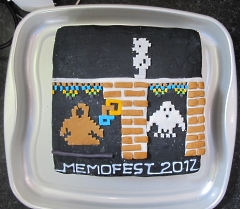 |
As I was not able to take much part in this year's
event, I have gathered together some of the info and
photos posted by
Andy on his website and
Mark's post on Memorum and posted them below.
|
|
Hardware |
|
Martin had a selection of his MTX related
hardware on show |
The monitor on the left is displaying the VGA output
from CFX-II
with the mono monitor displaying the normal MTX
composite video output.
Martin's "MTX-mini" is
shown in the foreground (see below)
(Photo courtesy of Mark Kinsey) |
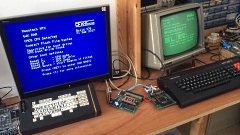 |
Close up of a CFX-II PCB - the main components include :
A 40 pin Parallax Propeller driving the VGA display
output
An 8 pin serial EPROM containing the Propeller
program code
A 32 pin CFX-II ROM
A Dallas DS1250Y
NVRAM providing a 512k SiDisc
An Altera MAX7128 CPLD
containing the glue logic
The CF card reader
(The
empty socket is for a 32k SRAM for MTX500 RAM upgrades)
Caution : Blatant plug to follow .
. . .
For details of CFX-II, including
availability, see
my webpage here
(Photo courtesy of Mark
Kinsey) |
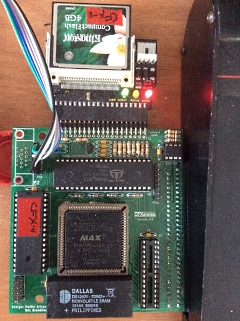 |
Martin's
REMEMOTECH was on show
REMEMOTECH is designed
by Andy Key and is a complete MTX/FDX/SDX system
implemented in VHDL on an Altera DE1 development board -
shown to the right of the picture
(Photo courtesy
of Mark Kinsey) |
 |
Martin's MTX Mini - hiding inside
a custom MDF keyboard
(Photo courtesy of Mark
Kinsey) |
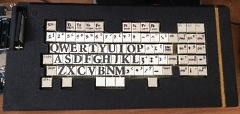 |
MTX Mini internals
(Photo courtesy of Mark
Kinsey) |
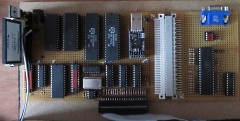 |
Description of MTX Mini (courtesy of
Martin)
The home made box hides a component
reduces sort of MTX like system, one of a couple of
experiments I'd tried with the intention of making a
replacement Main board using more modern components.
Under the cover is a Z80 running at 9.8304 Mhz (the
odd speed is a consequence of the requirements of the
serial connection), memory, CTC, SIO and serial to USB
adaptor, plus the various support chips.
On the
other side of the connector is a propeller video display
from the CFX built onto a MTXplus+ compatible connector.
In theory it could run MTX basic, however it would need
the display handler re-written. With only the 80 column
display it's really intended to run CPM. Which it will,
using the same disc images as the CFX and CFX-II, booted
from a modified CPM rom.
Over all though it's
still too big to fit the mounting rails under the
keyboard in a real MTX. More work needed!
|
Martin's set of
MTXPlus+
PCBs was also on display
If you look closely, you
might just make out the board designer's name on the
backplane PCB

(Photo courtesy of Mark Kinsey) |
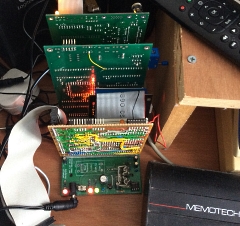 |
We had demo'ed MTXPlus+ at
Memofest 2016
and until then, I believed that it would be 100%
software compatible with the MTX.
However, we
found that Andy's
HEX-TRAIN game would not run due to differences
between the MTX TMS V9929 and the supposedly compatible
Yamaha V9958 used in MTXPlus+ |
Subsequently, Andy did some investigation of the
incompatibilities and was able to demo a version of
HEX-TRAIN for MTXPlus+ at this year's Memofest - thanks
Andy !
You can read Andy's description of how he
managed to get HEX-TRAIN working on MTXPlus+ on his
website
here.
(Photo courtesy of Mark Kinsey) |
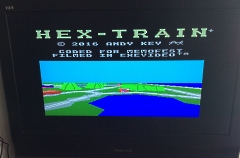 |
Jim brought along his
Memotalk, a speech synthesizer for the MTX
(Photo from Memofest 2013, courtesy of Andy Key) |
 |
Martin removed the Memotalk PCB from the case
As
shown in the photo, the device used a
GI SP0256-AL2 digital speech generator
(Photo courtesy of Martin Allcorn) |
 |
Solder side of the Memotalk PCB
(Photo courtesy of Martin Allcorn) |
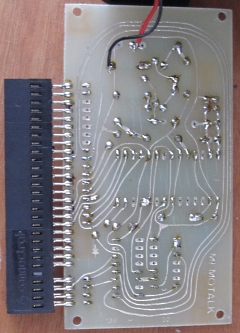 |
Apparently somewhat confused as to what Memofest was all
about
Jon
Bradbury took along some random hardware . . . .

Although, both systems being capable of
running CP/M, I believe(from
Andy's report, that they did generate some
interesting discussions |
A Tandy/Radio Shack
TRS-80 Model II . . . .
(Photo courtesy
of Andy Key) |
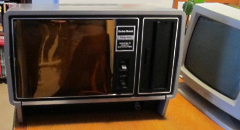 |
And an Amstrad (PCW?)
(Photo courtesy of Andy Key) |
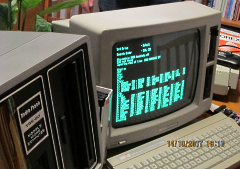 |
|
Z80 Coding Challenge |
Although he did not attend the event, Tony Brewer had
kicked off a Z80 coding challenge to be judged at the
event. See
this Memorum page for details.
Although there
were a number of entries, nobody was able to beat Tony's
model answer, so no winner was declared. |
|
New Game |
Paul Daniels showed off his new game.
From afar (Singapore) it looked like a PacMan
variant, but Martin has advised that it's a combination
of driving game and PacMan. The player drives in one
direction, the CPU in the other. The player has to
collect the dots avoiding a head-on crash with the CPU
car.
Andy bagged the high score prize
(Photo
courtesy of Andy Key) |
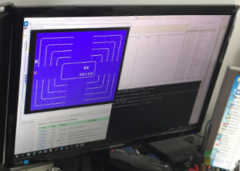 |
|
Andy's Corner |
As usual, Andy had something clever to show, this time,
it was his additions to the SDX boot ROM that included a
"Remote Control" feature, allowing data to be loaded to
the MTX over the RS232 port.
See
Andy's page for more details
(Photo courtesy
of Andy Key) |
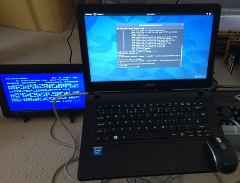 |
|
MEMU GUIs |
There was some discussion of
GUI front ends for
MEMU
Bill demonstrated his "Launcher" - a Python script
that takes the hard work out of using MEMU's many
command line parameters.
Launcher
is available here
I really like Launcher - particularly as Bill
included quite a few "nice-to-haves" at my request -
thanks Bill ! |
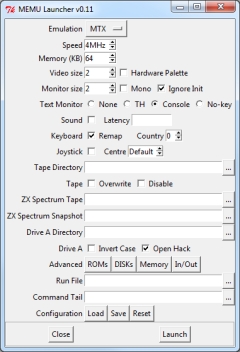 |
The webpage also
includes a Gamebase
installation, built by Paul for MEMU.
As
described on
Andy's page, "we spent a little time trying to set
up Gamebase to run
MEMU. If MEMU displays an error and terminates, it
writes a message to stderr, but this does not result in
a pop-up error window in Gamebase, making it a bit
tricky to diagnose problems." |
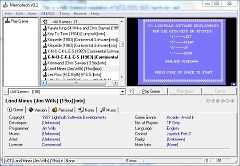 |
|
Memotech Hospital |
Paul's MTX
The first patient on
the table was Paul's MTX which had an intermitten video
fault. Due to luggage limitations, Paul only brought the
suspect Video daughter board along to
Memofest 2016,
but the daughter board proved to be working fine.
This year, will the complete MTX available, the
prospective surgeons (Mark and Andy) were unable to
reproduce the fault, so no progress was made on the day.
However, the following day, Martin noticed that it
"looked like one of the capacitors on the Video
Daughterboard could possibly be shorting to a via on
motherboard. One small piece of insulating tape later
the potential short was history. An hour long soak test
and still no problems so hopefully that's one system
fixed at least for now. " |
Jim's sexy red MTX
Jim's
pseudo Russian MTX was next up on Sunday morning, it
had a number of issues which Martin was able to resolve
as he describes below : |
 |
The 2nd repair
booked for Sunday Morning was Jim with his red MTX,
which had no display.
We connecter it up to the
monitor, and as expected the display was blank. However
in order to know whether we had a black screen which is
a common fault, or a blue one we connected the old TV.
Which produced a flashing cursor and "Seady" and a few
random exclamation marks on an otherwise working
display. We swapped the daughter board and then on the
next re-boot had the same display on both screens.
An close examination of Jim's daughter board
provided the answer. The was no link in either of the 2
jumpers that allow colour or mono composite output.
Fitting one link solved the missing display problem.
I plugged in the CFX-II board so that the start-up
screen would give us a display to help diagnose the
corruption of "Ready" into "Seady" and it was obvious
that the lowest bit of the display ram wasn't outputting
correctly. |
The
Circuit diagram suggested this should be the chip in
location G4 which we confirmed with a 10R resistor
grounding Pin 14.
That chip came out and was
replaces with a socket and one of the re-cycled 4116
chips from the spares box. Video corruption solved. |
 |
|
Next up was fitting the Magrom internally and a "test"
of some of the games. That revealed a 3rd problem, the
"H" key didn't work. Changing the cable didn't change
anything so we connected my keyboard, that worked as
expected, confirming the motherboard was fine and that
the issue was the keyboard itself. |
Experimentation
confirmed it wasn't just the "H" key, but also "F"
Cursor right and a few others. All keys connected to the
same pin on the keyboard connector.
Tracing with
the meter confirmed a break in between the connector and
the first of the keys connected to it. Being a Memotech,
that required a yellow wire to restore connection. |
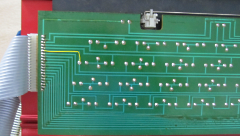 |
With
(hopefully) everything now fixed we were able to test
the Magrom and confirm for now at least the Ultra Rare
RED MTX WoW!! is working.
And Jim was finally
able to head for home with his repaired MTX and a large
chunk of the Pothole Pete themed cake as souvenirs of
his trip to the South Coast. |
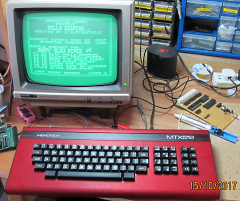 |
| |
|